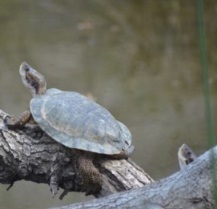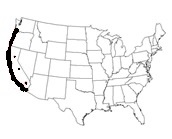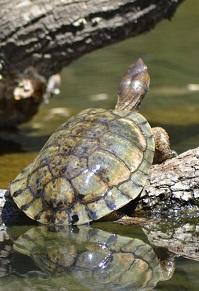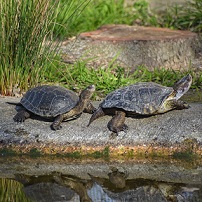Western Pond Turtle
Actinemys marmorata
- Habitat: Lives in freshwater lake and pond habitats
- Range: Western U.S.A
- Natural Diet: Aquatic invertebrates and plants
- Status in the Wild: THREATENED
All about the Western Pond Turtles
The Western Pond Turtle also called the Pacific Pond Turtle, lives along the Pacific Coast of North America. Like the tortoises, these turtles have smooth shells, but of a sleeker build, that protects them from predators. Since turtles spend a considerable proportion of their time swimming in the water, their sleeker bodies help them swim more efficiently. They have olive green or dark brown carapaces with pale yellow plastrons. Their legs and necks are olive green or dark brown speckled with pale yellow. They have blunt heads that look like tapering handles and well-developed legs. Their carapaces are usually around ¾ of a foot in length and they weigh about two and a half pounds.
Diet/ Habitat/ Range
Western Pond Turtles are endemic to the Pacific Coast of North America (Mexico and the United States of America) from the state of Washington through the states of Oregon and California in the USA to Baja California in Mexico. They live in freshwater habitats coming onshore to bask in the sun. They are omnivorous mainly feeding on aquatic invertebrates, fish, and pond vegetation. Young Western Pond Turtles are carnivorous predominantly feeding on aquatic invertebrates.
Behavior
Unlike mammals, and like other reptiles, Western Pond Turtles cannot thermoregulate. In the cold winter months, these turtles sink to the bottom of the water bodies they live in and slow down their activity levels to become almost dormant. This behavior is called brumation. When the climate starts warming up in spring, they emerge to bask in the sun.
Reproduction
Western Pond Turtles breed from late spring to summer. Breeding takes place in the water, after which the females come ashore to dig nests to lay their eggs. They are known to lay two clutches of eggs each breeding season. Parents do not incubate or care for their young and hatchlings are independent from the time they have hatched, heading directly toward a water body where they are lesser likely to be predated upon. Males and females sexually mature around eight years of age.
Conservation/Status
Since the populations in the wild are not
affected by habitat fragmentation, they are categorized as Least
Concern by the International Union for World Conservation.
Since wild Western Pond Turtles’ population numbers are still in
decline, the International Union for the Conservation of Nature has
categorized them as Vulnerable. The main factors that influence
their population decline are, habitat destruction and fragmentation
due to human pressure, pet trade, natural disasters caused by
drought, fires, and flooding, and competition with invasive species
such as the red-eared sliders. The U.S. federal government has not
added this species to its endangered species list due to the dearth
of scientific research on this species. In the last 20 years, this
species has been considered extinct in Canada. In the states of
Washington and Oregon where their wild population numbers have
depleted considerably, they are listed as endangered and sensitive
with critical standing respectively. The California Department of
Fish and Wildlife have also listed them as species of special
concern. Since the mortality rate of turtle hatchlings is high, to
conserve the species the state forest departments of California,
Oregon, and Washington collaborated with some universities and zoos
within their states 20 years ago to start the head-start program.
This program focuses on the collection of turtle eggs from the wild
that are taken to zoos where they are incubated. Hatchlings are
protected from natural predatory pressures and reintroduced to their
respective wild habitats when they are larger and less likely to be
predated upon.
The Association of Zoos and Aquariums (AZA) is focused on conserving Western Pond Turtles as one of their SAFE (Saving Animals From Extinction) species. Zoos across the United States, Canada, and Mexico are involved in their program and several are selected to breed their turtles to increase their population in the zoo community. AZA’s SAFE is also linked with other zoos globally and several individuals have been moved internationally to add new genes to increase genetic diversity. AZA SAFE proactively supports the assessment of western pond turtle populations and their threats, engages the public, and supports works that will increase the number of turtles living in natural areas in the species range.



